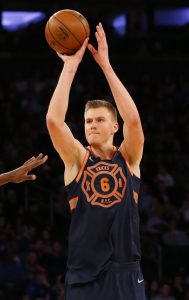After some up-and-down play in the early going this season, the Warriors have looked like their old selves over the last several weeks, winning 18 of their last 21 games to cement their spot atop the Western Conference. While there was never any doubt that Golden State would be the team to beat in the West, it remains unclear which conference rival will be the Dubs’ biggest threat this spring.
The Nuggets and Thunder currently have comfortable holds on the second and third seeds in the West and are in good position to capture home court advantage for the first round of the playoffs. However, both squads are unproven in the playoffs — Oklahoma City hasn’t won a postseason series since Kevin Durant‘s departure in 2016, and Denver hasn’t even made the postseason since 2013. Led by a pair of MVP candidates in Nikola Jokic and Paul George, the Nuggets and Thunder are formidable, but neither team looks like a lock to advance to the Western Finals.
Like the Thunder, the fourth-seeded Trail Blazers were quickly dispatched in the first round of last year’s postseason and still have to prove that they can make a deep playoff run. The Rockets (fifth) and the Jazz (seventh) were considered two of Golden State’s most dangerous challengers coming into the season, but have endured some bumps along the road and have had to re-establish themselves as legit threats to win multiple postseason series.
The Spurs don’t appear to be the legit title contenders they’ve been in most seasons under Gregg Popovich, but they’ve still played well enough to rank sixth in the conference and have a number of impressive wins on their 2018/19 résumé. The Lakers, meanwhile, are under .500 and out of the playoff picture for now, but could be a scary first-round matchup if they sneak into the top eight — after all, LeBron James hasn’t watched the NBA Finals from home since 2010.
What do you think? Which of the non-Warriors teams in the West poses the biggest threat to Golden State in the postseason? Which team do you expect to make it through two rounds to face the Dubs in the Western Conference Finals this spring?
Vote in our poll, then head to the comment section below to share your thoughts!
Trade Rumors app users, click here to vote.

 A top-14 pick who does not meet the starter criteria will receive a qualifying offer equal to the amount the 15th overall pick would receive if he signed for 120% of the rookie scale.
A top-14 pick who does not meet the starter criteria will receive a qualifying offer equal to the amount the 15th overall pick would receive if he signed for 120% of the rookie scale.